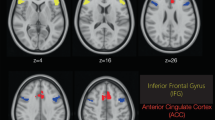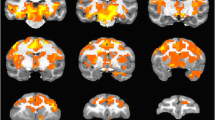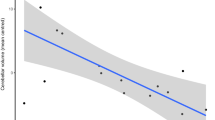Abstract
Rationale
The N-methyl-D-aspartate (NMDA) receptor antagonist ketamine provides a pragmatic approach to address the link between glutamate-mediated changes in brain function and psychosis-like experiences. Most studies using PET or BOLD fMRI have assessed these symptoms broadly, which may limit inference about specific mechanisms.
Objectives
The objective of this study is to identify the cerebral blood flow (CBF) correlates of ketamine-induced psychopathology, focusing on individual psychotomimetic symptom dimensions, which may have separable neurobiological substrates.
Methods
We measured validated psychotomimetic symptom factors following intravenous ketamine administration in 23 healthy male volunteers (10 given a lower dose and 13 a higher dose) and correlated ketamine-induced changes in symptoms with regional changes in CBF, measured non-invasively using arterial spin labelling (ASL).
Results
The main effect of ketamine paralleled previous studies, with increases in CBF in anterior and subgenual cingulate cortex and decreases in superior and medial temporal cortex. Subjective effects were greater in the high-dose group. For this group, ketamine-induced anhedonia inversely related to orbitofrontal cortex CBF changes and cognitive disorganisation was positively correlated with CBF changes in posterior thalamus and the left inferior and middle temporal gyrus. Perceptual distortion was correlated with different regional CBF changes in the low- and high-dose groups.
Conclusions
Here, we provide evidence for the sensitivity of ASL to the effects of ketamine and the strength of subjective experience, suggesting plausible neural mechanisms for ketamine-induced anhedonia and cognitive disorganisation.



Similar content being viewed by others

References
Absalom AR, Lee M, Menon DK, Sharar SR, De Smet T, Halliday J et al (2007) Predictive performance of the Domino, Hijazi, and Clements models during low-dose target-controlled ketamine infusions in healthy volunteers. Br J Anaesth 98(5):615–623. doi:10.1093/bja/aem063
Aguirre GK, Detre JA, Zarahn E, Alsop DC (2002) Experimental design and the relative sensitivity of BOLD and perfusion fMRI. Neuroimage 15(3):488--500. doi:10.1006/nimg.2001.0990
Andrews J, Wang L, Csernansky JG, Gado MH, Barch DM (2006) Abnormalities of thalamic activation and cognition in schizophrenia. Am J Psychiatry 163(3):463–469. doi:10.1176/appi.ajp.163.3.463
Attwell D, Buchan AM, Charpak S, Lauritzen M, Macvicar BA, Newman EA (2010) Glial and neuronal control of brain blood flow. Nature 468(7321):232–243. doi:10.1038/nature09613
Blankenburg F, Ruff CC, Deichmann R, Rees G, Driver J (2006) The cutaneous rabbit illusion affects human primary sensory cortex somatotopically. PLoS Biol 4(3), e69. doi:10.1371/journal.pbio.0040069
Bremner JD, Krystal JH, Putnam FW, Southwick SM, Marmar C, Charney DS et al (1998) Measurement of dissociative states with the Clinician-Administered Dissociative States Scale (CADSS). J Trauma Stress 11(1):125–136. doi:10.1023/A:1024465317902
Bruns A, Kunnecke B, Risterucci C, Moreau JL, von Kienlin M (2009) Validation of cerebral blood perfusion imaging as a modality for quantitative pharmacological MRI in rats. Magn Reson Med 61(6):1451–1458. doi:10.1002/mrm.21779
Carhart-Harris RL, Erritzoe D, Williams T, Stone JM, Reed LJ, Colasanti A et al (2012) Neural correlates of the psychedelic state as determined by fMRI studies with psilocybin. Proc Natl Acad Sci U S A 109(6):2138–2143. doi:10.1073/pnas.1119598109
Cavazzuti M, Porro CA, Biral GP, Benassi C, Barbieri GC (1987) Ketamine effects on local cerebral blood flow and metabolism in the rat. J Cereb Blood Flow Metab 7(6):806–811. doi:10.1038/jcbfm.1987.138
Corlett PR, Honey GD, Krystal JH, Fletcher PC (2011) Glutamatergic model psychoses: prediction error, learning, and inference. Neuropsychopharmacology 36(1):294–315. doi:10.1038/npp.2010.163
Dawson N, Morris BJ, Pratt JA (2013) Subanaesthetic ketamine treatment alters prefrontal cortex connectivity with thalamus and ascending subcortical systems. Schizophr Bull 39(2):366–377. doi:10.1093/schbul/sbr144
De Simoni S, Schwarz AJ, O’Daly OG, Marquand AF, Brittain C, Gonzales C et al (2013) Test-retest reliability of the BOLD pharmacological MRI response to ketamine in healthy volunteers. Neuroimage 64:75–90. doi:10.1016/j.neuroimage.2012.09.037
Deakin JF, Lees J, McKie S, Hallak JE, Williams SR, Dursun SM (2008) Glutamate and the neural basis of the subjective effects of ketamine: a pharmaco-magnetic resonance imaging study. Arch Gen Psychiatry 65(2):154–164. doi:10.1001/archgenpsychiatry.2007.37
Griffin KM, Blau CW, Kelly ME, O’Herlihy C, O’Connell PR, Jones JF et al (2010) Propofol allows precise quantitative arterial spin labelling functional magnetic resonance imaging in the rat. Neuroimage 51(4):1395–1404. doi:10.1016/j.neuroimage.2010.03.024
Handley R, Zelaya FO, Reinders AA, Marques TR, Mehta MA, O’Gorman R et al (2013) Acute effects of single-dose aripiprazole and haloperidol on resting cerebral blood flow (rCBF) in the human brain. Hum Brain Mapp 34(2):272–282. doi:10.1002/hbm.21436
Holcomb HH, Lahti AC, Medoff DR, Weiler M, Tamminga CA (2001) Sequential regional cerebral blood flow brain scans using PET with H2(15)O demonstrate ketamine actions in CNS dynamically. Neuropsychopharmacology 25(2):165–172. doi:10.1016/S0893-133X(01)00229-9
Holcomb HH, Lahti AC, Medoff DR, Cullen T, Tamminga CA (2005) Effects of noncompetitive NMDA receptor blockade on anterior cingulate cerebral blood flow in volunteers with schizophrenia. Neuropsychopharmacology 30(12):2275–2282. doi:10.1038/sj.npp.1300824
Kircher TT, Liddle PF, Brammer MJ, Williams SC, Murray RM, McGuire PK (2001) Neural correlates of formal thought disorder in schizophrenia: preliminary findings from a functional magnetic resonance imaging study. Arch Gen Psychiatry 58(8):769–774
Kringelbach ML (2005) The human orbitofrontal cortex: linking reward to hedonic experience. Nat Rev Neurosci 6(9):691–702. doi:10.1038/nrn1747
Krystal JH, Karper LP, Seibyl JP, Freeman GK, Delaney R, Bremner JD et al (1994) Subanesthetic effects of the noncompetitive NMDA antagonist, ketamine, in humans. Psychotomimetic, perceptual, cognitive, and neuroendocrine responses. Arch Gen Psychiatry 51(3):199–214
Lahti AC, Holcomb HH, Medoff DR, Tamminga CA (1995) Ketamine activates psychosis and alters limbic blood flow in schizophrenia. Neuroreport 6(6):869–872
Lally N, Nugent AC, Luckenbaugh DA, Niciu MJ, Roiser JP, Zarate CA Jr (2015) Neural correlates of change in major depressive disorder anhedonia following open-label ketamine. J Psychopharmacol. doi:10.1177/0269881114568041
Langsjo JW, Kaisti KK, Aalto S, Hinkka S, Aantaa R, Oikonen V et al (2003) Effects of subanesthetic doses of ketamine on regional cerebral blood flow, oxygen consumption, and blood volume in humans. Anesthesiology 99(3):614–623
Langsjo JW, Salmi E, Kaisti KK, Aalto S, Hinkka S, Aantaa R et al (2004) Effects of subanesthetic ketamine on regional cerebral glucose metabolism in humans. Anesthesiology 100(5):1065–1071
Luo F, Schmidt KF, Fox GB, Ferris CF (2009) Differential responses in CBF and CBV to cocaine as measured by fMRI: implications for pharmacological MRI signals derived oxygen metabolism assessment. J Psychiatr Res 43(12):1018–1024. doi:10.1016/j.jpsychires.2008.11.009
Maldjian JA, Laurienti PJ, Kraft RA, Burdette JH (2003) An automated method for neuroanatomic and cytoarchitectonic atlas-based interrogation of fMRI data sets. Neuroimage 19(3):1233–1239
Marquand AF, O’Daly OG, De Simoni S, Alsop DC, Maguire RP, Williams SC et al (2012) Dissociable effects of methylphenidate, atomoxetine and placebo on regional cerebral blood flow in healthy volunteers at rest: a multi-class pattern recognition approach. Neuroimage 60(2):1015–1024. doi:10.1016/j.neuroimage.2012.01.058
Mason OJ, Morgan CJ, Stefanovic A, Curran HV (2008) The psychotomimetic states inventory (PSI): measuring psychotic-type experiences from ketamine and cannabis. Schizophr Res 103(1–3):138–142. doi:10.1016/j.schres.2008.02.020
Mikita N, Mehta MA, Zelaya FO, Stringaris A (2015) Using arterial spin labeling to examine mood states in youth. Brain Behav 5(6), e00339. doi:10.1002/brb3.339
Nemoto K, Mizukami K, Hori T, Tachikawa H, Ota M, Takeda T et al (2010) Hyperperfusion in primary somatosensory region related to somatic hallucination in the elderly. Psychiatry Clin Neurosci 64(4):421–425. doi:10.1111/j.1440-1819.2010.02101.x
Ojemann GA, Fedio P, Van Buren JM (1968) Anomia from pulvinar and subcortical parietal stimulation. Brain 91(1):99–116
Overall JF, Gorham DR (1962) The brief psychiatric rating scale. Psychol Rep 10:799–812
Rowland LM, Beason-Held L, Tamminga CA, Holcomb HH (2010) The interactive effects of ketamine and nicotine on human cerebral blood flow. Psychopharmacology (Berl) 208(4):575–584. doi:10.1007/s00213-009-1758-2
Sescousse G, Redoute J, Dreher JC (2010) The architecture of reward value coding in the human orbitofrontal cortex. J Neurosci: Off J Soc Neurosci 30(39):13095–13104. doi:10.1523/JNEUROSCI.3501-10.2010
Sescousse G, Caldu X, Segura B, Dreher JC (2013) Processing of primary and secondary rewards: a quantitative meta-analysis and review of human functional neuroimaging studies. Neurosci Biobehav Rev 37(4):681–696. doi:10.1016/j.neubiorev.2013.02.002
Shergill SS, Cameron LA, Brammer MJ, Williams SC, Murray RM, McGuire PK (2001) Modality specific neural correlates of auditory and somatic hallucinations. J Neurol Neurosurg Psychiatry 71(5):688–690
Stewart SB, Koller JM, Campbell MC, Perlmutter JS, Black KJ (2015) Additive global cerebral blood flow normalization in arterial spin labeling perfusion imaging. Peer J 3, e834. doi:10.7717/peerj.834
Stone JM, Erlandsson K, Arstad E, Squassante L, Teneggi V, Bressan RA et al (2008) Relationship between ketamine-induced psychotic symptoms and NMDA receptor occupancy: a [(123)I]CNS-1261 SPET study. Psychopharmacology 197(3):401–408. doi:10.1007/s00213-007-1047-x
Stone JM, Dietrich C, Edden R, Mehta MA, De Simoni S, Reed LJ et al (2012) Ketamine effects on brain GABA and glutamate levels with 1H-MRS: relationship to ketamine-induced psychopathology. Mol Psychiatry 17(7):664–665. doi:10.1038/mp.2011.171
Stone JM, Pepper F, Fam J, Furby H, Hughes E, Morgan C et al (2013) Glutamate, N-acetyl aspartate and psychotic symptoms in chronic ketamine users. Psychopharmacology. doi:10.1007/s00213-013-3354-8
Tolentino NJ, Wierenga CE, Hall S, Tapert SF, Paulus MP, Liu TT et al (2011) Alcohol effects on cerebral blood flow in subjects with low and high responses to alcohol. Alcohol Clin Exp Res 35(6):1034–1040. doi:10.1111/j.1530-0277.2011.01435.x
van Hell HH, Bossong MG, Jager G, Kahn RS, Ramsey NF (2011) Methods of the pharmacological imaging of the cannabinoid system (PhICS) study: towards understanding the role of the brain endocannabinoid system in human cognition. Int J Methods Psychiatr Res 20(1):10–27. doi:10.1002/mpr.327
Zelaya FO, Zois E, Muller-Pollard C, Lythgoe DJ, Lee S, Andrews C et al (2012) The response to rapid infusion of fentanyl in the human brain measured using pulsed arterial spin labelling. Magma 25(2):163–175. doi:10.1007/s10334-011-0293-4
Acknowledgments
We thank Dr. David Alsop for making available to us the pCASL pulse sequences employed in this work, Professor Anthony Absalom for supplying the Stanpump software for the implementation of the Clements 250 infusion model and the radiographers at the Centre for Neuroimaging Sciences and Astrid Pauls for helping with the data collection.
Author information
Authors and Affiliations
Corresponding author
Ethics declarations
Conflict of interest
The funders had no role in study design, data collection and analysis, decision to publish or preparation of the manuscript.
Funding
TP was supported by the National Institute for Health Research (NIHR). JMS was supported by the National Institute for Health Research (NIHR) Biomedical Research Centre for Mental Health at the South London and Maudsley NHS Foundation Trust and Institute of Psychiatry, King’s College London, and by the Yale Center for Clinical Investigation (UL1RR024139), U.S. Department of Veterans Affairs via its support for the National Center for Post Traumatic Stress Disorder and Consortium to Alleviate PTSD, and the U.S. National Institute on Alcohol Abuse and Alcoholism (P50AA012879). He has received honoraria from Janssen Pharmaceuticals, Behrenberg Bank, AstraZeneca, Pfizer, Sunovion and Hoffman-La Roche Ltd. MAM has consulted for Cambridge Cognition and Lundbeck and received payment for contribution towards educational materials for Shire in the past 5 years. This study was supported by a grant from Eli Lilly and Company. We also thank the Wellcome Trust and EPSRC for continued funding of the Centre for Neuroimaging Sciences.
Rights and permissions
About this article
Cite this article
Pollak, T.A., De Simoni, S., Barimani, B. et al. Phenomenologically distinct psychotomimetic effects of ketamine are associated with cerebral blood flow changes in functionally relevant cerebral foci: a continuous arterial spin labelling study. Psychopharmacology 232, 4515–4524 (2015). https://doi.org/10.1007/s00213-015-4078-8
Received:
Accepted:
Published:
Issue Date:
DOI: https://doi.org/10.1007/s00213-015-4078-8



